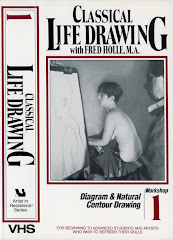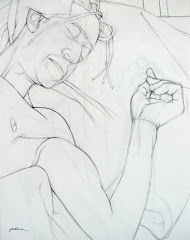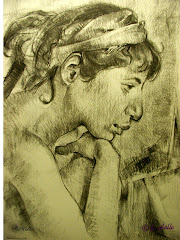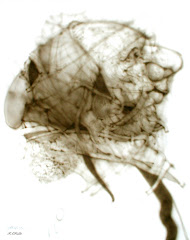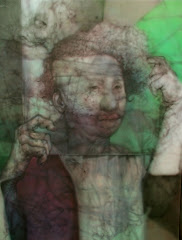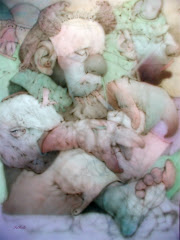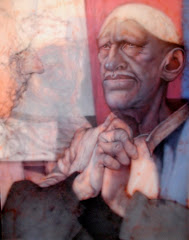Monday, September 3, 2012
Tuesday, September 1, 2009
Life Drawing, A Way of Life
I’m a figural artist.
More specifically, I’m a painter/printmaker who’s aware that drawing is the genesis of all of my work. I constantly draw from models, partly for the great pleasure it affords but, primarily, to maintain perceptual sensitivity and to obtain fresh data to fill a reservoir of images that may be tapped, when needed, for my paintings and prints.
This activity enables me to develop complete works from my imagination.
Drawing from the model is always, of course, the best situation, but practice is the key issue. The ultimate goal is to sensitize your perception and hone your skills to the point where your assimilation of various drawing approaches becomes intuitive and second nature. In order to sustain a disciplined practice regimen, we suggest drawing from photographs when live models are not available. This practice can be supported by historical works created by artists from Delacroix to Warhol as illustrated in “The Painter and the Photograph” by Van Derek Coke (1972), University of New Mexico Press. The photos should be of interesting people whose images offer a lot of data. Magazines like National Geographic offer such photos and can be found at thrift stores such as the Good Will and Salvation Army. The photos can be pre-composed through the use of a composition window which will be, by ratio, the same size and shape as your drawing paper. Note: It is best to use a heavy piece of cardboard for the composition window.
As a teacher, I consider drawing to be an indispensable discipline for visual artists of all persuasions, be they academic, classical, abstractionist and even the non-objective artist. The best and limitless source of ideas and inspiration is nature itself. The danger for visual artists is that they begin to echo themselves with each work becoming more shallow and boring than the previous effort. Nature, in whatever form, the figure, still-life or landscape, are sources which replenish, refresh and motivate one’s work.
For this reason, I welcomed the opportunity to participated in the production of a series of five CLASSICAL LIFE DRAWING videos, each covering a specific aspect of figure drawing.
They remain in production under the trademark, Artist-in-Residence® videos. For more information, visit my website: www.bensco.com/holle/
I’m a figural artist.
More specifically, I’m a painter/printmaker who’s aware that drawing is the genesis of all of my work. I constantly draw from models, partly for the great pleasure it affords but, primarily, to maintain perceptual sensitivity and to obtain fresh data to fill a reservoir of images that may be tapped, when needed, for my paintings and prints.
This activity enables me to develop complete works from my imagination.
Drawing from the model is always, of course, the best situation, but practice is the key issue. The ultimate goal is to sensitize your perception and hone your skills to the point where your assimilation of various drawing approaches becomes intuitive and second nature. In order to sustain a disciplined practice regimen, we suggest drawing from photographs when live models are not available. This practice can be supported by historical works created by artists from Delacroix to Warhol as illustrated in “The Painter and the Photograph” by Van Derek Coke (1972), University of New Mexico Press. The photos should be of interesting people whose images offer a lot of data. Magazines like National Geographic offer such photos and can be found at thrift stores such as the Good Will and Salvation Army. The photos can be pre-composed through the use of a composition window which will be, by ratio, the same size and shape as your drawing paper. Note: It is best to use a heavy piece of cardboard for the composition window.
As a teacher, I consider drawing to be an indispensable discipline for visual artists of all persuasions, be they academic, classical, abstractionist and even the non-objective artist. The best and limitless source of ideas and inspiration is nature itself. The danger for visual artists is that they begin to echo themselves with each work becoming more shallow and boring than the previous effort. Nature, in whatever form, the figure, still-life or landscape, are sources which replenish, refresh and motivate one’s work.
For this reason, I welcomed the opportunity to participated in the production of a series of five CLASSICAL LIFE DRAWING videos, each covering a specific aspect of figure drawing.
They remain in production under the trademark, Artist-in-Residence® videos. For more information, visit my website: www.bensco.com/holle/
Wednesday, June 17, 2009
GNOMEGAME, REDUX
Enter the Airbrush
As stated earlier, at the outset of Gnomegame, I adopted a painting approach similar to Sandro Botticelli... small hatching brushstrokes made with pointed sable brushes. Needless to say the approach, while ultimately satisfying, was tedious by nature. It was also a process quite alien to the initial gestural attack.
In a continuation of the serendipity that led to Gnomegame, ENTER THE AIRBRUSH.
It happened while visiting a friend and fellow artist. He had just acquired an inexpensive airbrush and was very excited about it.
Having been exposed to many commercial illustrations created with an airbrush (Time magazine covers, Petty Girls, slick advertising illustrations, etc.), I had developed a strong aversion to that particular painting system.
My friend, in an attempt to amuse (and influence) me, kept insisting that I try using the “brush”. He overcame my resistance by filling his airbrush with India ink and placing an easel with board and paper in front of me.
He turned the compressor on, handed me the brush and I had no choice but to comply.
I opened with a gestural flourish, no subject in mind, more in the nature of a calligraphic drawing. In the few seconds that it took to accomplish the opening, I immediately recognized (or discovered) a potential image. I moved to strengthen it and started to develop modeling to give it dimension. That whole process took less than five minutes...no masterpiece, mind you, but an acceptable effort which, as it developed, gave me insight into a way to synthesized my drawing and painting into one act.
I felt as though I had an airbrush in my hand all my life.
I was thrilled.
As I was leaving, my generous friend offered to loan his airbrush to me, and I jumped at the chance.
Arriving home, I immediately set up and brought out a pad of paper. Two hours later, with experimental freehand "stuff" lying all around me, I realized that I had discovered the perfect medium for me. For the next few days, I worked incessantly drawing with it and incorporating color layer upon layer in painting after painting.
A week passed, I heard a knock at the door and peeked out the window. It was my friend. I knew he probably wanted his equipment back but I wasn’t ready to return it. My obsession with his airbrush prompted me to be very quiet and give the impression that I wasn’t home. This charade repeated itself for two more visits by him. Then, I finally gave in, returned
his airbrush to him and acquired my own within 24 hours.
Ultimately, he was amused by my confessed subterfuge and, in gentle retribution, remarked, “you know, Fred, it’s the perfect voyeur's medium. You never touch the canvas”.
My reply, “that's OK”.
Enter the Airbrush
As stated earlier, at the outset of Gnomegame, I adopted a painting approach similar to Sandro Botticelli... small hatching brushstrokes made with pointed sable brushes. Needless to say the approach, while ultimately satisfying, was tedious by nature. It was also a process quite alien to the initial gestural attack.
In a continuation of the serendipity that led to Gnomegame, ENTER THE AIRBRUSH.
It happened while visiting a friend and fellow artist. He had just acquired an inexpensive airbrush and was very excited about it.
Having been exposed to many commercial illustrations created with an airbrush (Time magazine covers, Petty Girls, slick advertising illustrations, etc.), I had developed a strong aversion to that particular painting system.
My friend, in an attempt to amuse (and influence) me, kept insisting that I try using the “brush”. He overcame my resistance by filling his airbrush with India ink and placing an easel with board and paper in front of me.
He turned the compressor on, handed me the brush and I had no choice but to comply.
I opened with a gestural flourish, no subject in mind, more in the nature of a calligraphic drawing. In the few seconds that it took to accomplish the opening, I immediately recognized (or discovered) a potential image. I moved to strengthen it and started to develop modeling to give it dimension. That whole process took less than five minutes...no masterpiece, mind you, but an acceptable effort which, as it developed, gave me insight into a way to synthesized my drawing and painting into one act.
I felt as though I had an airbrush in my hand all my life.
I was thrilled.
As I was leaving, my generous friend offered to loan his airbrush to me, and I jumped at the chance.
Arriving home, I immediately set up and brought out a pad of paper. Two hours later, with experimental freehand "stuff" lying all around me, I realized that I had discovered the perfect medium for me. For the next few days, I worked incessantly drawing with it and incorporating color layer upon layer in painting after painting.
A week passed, I heard a knock at the door and peeked out the window. It was my friend. I knew he probably wanted his equipment back but I wasn’t ready to return it. My obsession with his airbrush prompted me to be very quiet and give the impression that I wasn’t home. This charade repeated itself for two more visits by him. Then, I finally gave in, returned
his airbrush to him and acquired my own within 24 hours.
Ultimately, he was amused by my confessed subterfuge and, in gentle retribution, remarked, “you know, Fred, it’s the perfect voyeur's medium. You never touch the canvas”.
My reply, “that's OK”.
Friday, June 12, 2009
The Birth of GNOMEGAME
FRED HOLLE
The Birth of GNOMEGAME
The birth of Gnomegame came after a gradual epiphany I had around 1960. Until then, my passion and mode of expression was abstract expressionism (along with most of the younger artists of the time.)
However, during "informal social gatherings" at various local bars, I would constantly scrawl small gestural figure scribbles on bar napkins (a lot of bar napkins) while casual conversation went on. On leaving, I would jam them in my pockets.
When I returned to my studio, I would empty those pockets on a utility table and think nothing about them after that. There came a point where they had accumulated to an uncontrollable degree so I started to dispose of them. Before doing so, I decided to take one last look at what I had previously thought were just doodles.
Then it hit me... Could this be my Form?
Specifically, the approach I developed was the antithesis of the loose, impasto action painting of abstract expressionism. I did start with a rapid gestural attack very similar to the bar napkin drawings. But as I formed the painting, i would use pointed sable brushes and short hatching brushstrokes of various colors (similar to Botticelli’s approach) and attempted to achieve a more traditional illusory effect. After “Steppenwolf”, utilizing large and small canvases, Gnomegame was born.
Perhaps the most important moment in the life of any artist is finding out who he/she is. I was excited by my new awareness and reveled in the pleasure and even joy of doing something unique to me as an artist. The series started to feel very natural and while the paintings were still a struggle at times, it was a struggle of choices rather then confusion or ineptitude.
Eventually, many asked me the questions... where did these works come from, what was your basic motivation and what do they mean? I was always aware of the "bar drawings" and I related that story when asked but I didn’t quite know the purpose of the works as this Form was evolving.
As the Gnomegame Series developed, It’s guiding CONCEPT began to clearly relate to the revelation and personification of human attitudes ranging from foibles to the darker edges of human nature. My awareness of the particular “attitude” being manifested on the picture plane usually crystallized as the painting unfolded. That is, I didn’t preconceive. Perhaps this approach was a carry-over from my previous years as an Abstract- Expressionist painter. I had (and have) the greatest faith in intuition and the truth it generates.
Recollections of a Navy psychological project for which I illustrated made me realize that, while the content of the paintings were personal insights into my own nature, I was also presenting them to an audience as images on which they could reflect and, hopefully, learn something about themselves. An unexpected event occurred confirming the above while showing my work to a gallery director.
As the Director viewed my work, a very prosperous looking woman, obviously a patron, came into the gallery and walked around studying each of my paintings.
The Gallery director noticed this and asked her what she thought. Her answer made everything clear to me. She answered, “I’m just trying to figure out which one of these I am.”
BINGO!
The Birth of GNOMEGAME
The birth of Gnomegame came after a gradual epiphany I had around 1960. Until then, my passion and mode of expression was abstract expressionism (along with most of the younger artists of the time.)
However, during "informal social gatherings" at various local bars, I would constantly scrawl small gestural figure scribbles on bar napkins (a lot of bar napkins) while casual conversation went on. On leaving, I would jam them in my pockets.
When I returned to my studio, I would empty those pockets on a utility table and think nothing about them after that. There came a point where they had accumulated to an uncontrollable degree so I started to dispose of them. Before doing so, I decided to take one last look at what I had previously thought were just doodles.
Then it hit me... Could this be my Form?
Specifically, the approach I developed was the antithesis of the loose, impasto action painting of abstract expressionism. I did start with a rapid gestural attack very similar to the bar napkin drawings. But as I formed the painting, i would use pointed sable brushes and short hatching brushstrokes of various colors (similar to Botticelli’s approach) and attempted to achieve a more traditional illusory effect. After “Steppenwolf”, utilizing large and small canvases, Gnomegame was born.
Perhaps the most important moment in the life of any artist is finding out who he/she is. I was excited by my new awareness and reveled in the pleasure and even joy of doing something unique to me as an artist. The series started to feel very natural and while the paintings were still a struggle at times, it was a struggle of choices rather then confusion or ineptitude.
Eventually, many asked me the questions... where did these works come from, what was your basic motivation and what do they mean? I was always aware of the "bar drawings" and I related that story when asked but I didn’t quite know the purpose of the works as this Form was evolving.
As the Gnomegame Series developed, It’s guiding CONCEPT began to clearly relate to the revelation and personification of human attitudes ranging from foibles to the darker edges of human nature. My awareness of the particular “attitude” being manifested on the picture plane usually crystallized as the painting unfolded. That is, I didn’t preconceive. Perhaps this approach was a carry-over from my previous years as an Abstract- Expressionist painter. I had (and have) the greatest faith in intuition and the truth it generates.
Recollections of a Navy psychological project for which I illustrated made me realize that, while the content of the paintings were personal insights into my own nature, I was also presenting them to an audience as images on which they could reflect and, hopefully, learn something about themselves. An unexpected event occurred confirming the above while showing my work to a gallery director.
As the Director viewed my work, a very prosperous looking woman, obviously a patron, came into the gallery and walked around studying each of my paintings.
The Gallery director noticed this and asked her what she thought. Her answer made everything clear to me. She answered, “I’m just trying to figure out which one of these I am.”
BINGO!
Thursday, June 4, 2009
Subscribe to:
Comments (Atom)
.jpg)

